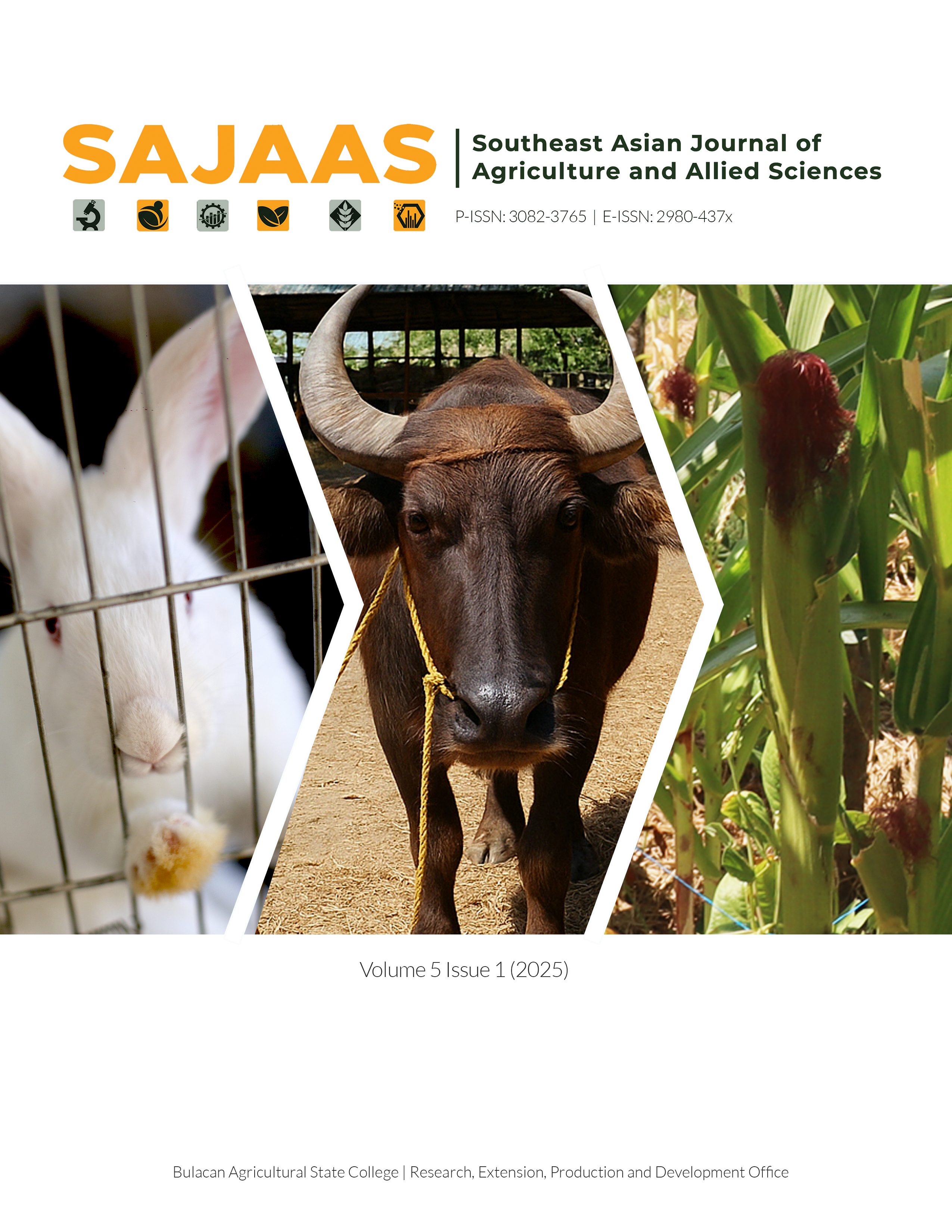Abstract
This study assessed the impact of the coffee rejuvenation and rehabilitation project on coffee growers in Brgy. Talbak, Doña Remedios Trinidad, Bulacan. The study employed a descriptive research design to assess the impact of the project on 36 coffee farmers in the study area. The result characterized the socio-demographic and farm profiles, the usefulness of the intervention provided, the benefits of the project, and the problems encountered by coffee farmers. The majority of coffee farmers surveyed were male, married, and members of the farmers' group. Though many of them were elementary and high school undergraduates, they had already received training in coffee production and processing. The majority were owners of the farm and planted the Robusta variety of coffee. The findings showed that from 2018, coffee rejuvenation and rehabilitation have led to a decrease in production from an average of 257.25 kg to 142.28 kg and income from an average of ₱28,297.50 to ₱17,073.33. Timing is crucial for successful rejuvenation; ideally, it should begin during the rainy season or when soil moisture is sufficient to promote optimal plant recovery and minimize stress. Also, some external factors were observed to contribute to the decrease in coffee production. One of these was the insufficient technical training provided to coffee growers, as each farmer attended only an average of five to six trainings covering coffee production to marketing. Furthermore, the improper and insufficient application of fertilizer was also identified as a reason for the lower coffee yields. Lastly, given the observed decrease in production and income, ongoing and targeted assistance from local and regional agricultural offices and extension workers is crucial to effectively guide farmers through the revitalization process and ensure the long-term success and sustainability of coffee yield in the municipality.
References
Aderolu, I. A., Babalola, F. D., Ugioro, O., Anagbogu, C. F., Ndagi, I., Mokwunye, F. C., & Asogwa, E. U. (2014). Production and marketing of Coffee (Coffea robusta) in Kogi State, Nigeria: Challenges and recommendation for intervention. Journal of Social Science Research, 3(2), 207–215. https://doi.org/10.24297/jssr.v3i2.3559
Department of Agriculture. (2015, January 2). Farmers urged to form co-ops for better access to DA programs. The Philippine Star. https://www.philstar.com/business/2015/01/02/1408524/farmers-urged-form-co-ops-better-access-da-programs
Djufry, F., Wulandari, S., & Villano, R. (2022). Climate smart agriculture implementation on coffee smallholders in Indonesia and strategy to accelerate. Land, 11(7), 1112. https://doi.org/10.3390/land11071112
Mananghaya, J. (2002, November 10). Coffee from Bulacan, anyone? The Philippine Star. https://www.philstar.com/business/agriculture/2002/11/10/183376/coffee-bulacan-anyone
Mbudzya, J. J., Gido, E. O., & Owuor, G. (2022). Effect of land tenure security on agricultural productivity among small-scale farmers in Kenya: A conditional mixed processes analysis. Cogent Economics & Finance, 10(1), 2139805. https://doi.org/10.1080/23311932.2022.2139805
Mendez, V. E., Bacon, C. M., Olson, M., Morris, K. S., & Shattuck, A. (2010). Agrobiodiversity and shade coffee smallholder livelihoods: A review and synthesis of ten years of research in Central America. The Professional Geographer, 62(3), 357–376. https://doi.org/10.1080/00330124.2010.483638
Ngeywo, J., Basweti, E., & Shitandi, A. (2015). Influence of gender, age, marital status and farm size on coffee production: A case of Kisii County, Kenya. Asian Journal of Agricultural Extension, Economics & Sociology, 5(3), 117–125. https://doi.org/10.9734/AJAEES/2015/15702
Observatory of Economic Complexity. (n.d.). Coffee in Philippines trade. The Observatory of Economic Complexity. https://oec.world/en/profile/bilateral-product/coffee/reporter/phl
Philippine Statistics Authority. (2023). Major non-food and industrial crops quarterly bulletin, April–June 2023. Philippine Statistics Authority. https://psa.gov.ph/major-non-food-industrial-crops/coffee
Quiroga, S., Suárez, C., Solís, J. D., & Martinez-Juarez, P. (2020). Framing vulnerability and coffee farmers’ behaviour in the context of climate change adaptation in Nicaragua. World Development, 126, 104733. https://doi.org/10.1016/j.worlddev.2019.104733
Sarirahayu, K., & Aprianingsih, A. (2018). Strategy to improving smallholder coffee farmers productivity. The Asian Journal of Technology Management, 11(1), 1–9. https://doi.org/10.12695/ajtm.2018.11.1.1
Siles, P., Cerdán, C. R., & Staver, C. (2022). Smallholder coffee in the global economy—A framework to explore transformation alternatives of traditional agroforestry for greater economic, ecological, and livelihood viability. Frontiers in Sustainable Food Systems, 6, 808207. https://doi.org/10.3389/fsufs.2022.808207
Vaast, P., Bertrand, B., Perriot, J. J., Guyot, B., & Génard, M. (2006). Fruit thinning and shade influence bean characteristics and beverage quality of coffee (Coffea arabica L.) under optimal conditions. Journal of the Science of Food and Agriculture, 86(2), 197–204. https://doi.org/10.1002/jsfa.2338
Viana, M. V. (n.d.). How to prune your coffee trees in an agroforestry system. In Wikifarmer. Retrieved August 8, 2025, from https://wikifarmer.com/library/en/article/how-to-prune-your-coffee-trees-in-an-agroforestry-system
Willer, H., & Kilcher, L. (2011). The world of organic agriculture: Statistics and emerging trends 2011. IFOAM and FiBL. https://www.fibl.org/fileadmin/documents/shop/1546-organic-world-2011.pdf

This work is licensed under a Creative Commons Attribution-NonCommercial-ShareAlike 4.0 International License.
Copyright (c) 2025 Southeast Asian Journal of Agriculture and Allied Sciences

